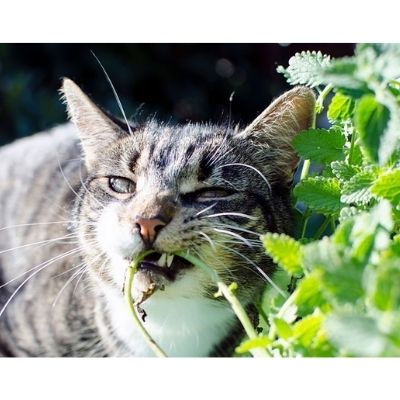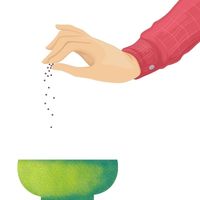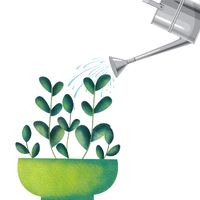
Botanical name : Nepeta cataria
Flavor Profile : Bitter and minty
As a garden herb, catnip originated in the dry regions of the Mediterranean, Europe, Asia, Eurasia, and Africa, and was introduced to North America by the earliest settlers. It eventually naturalized in the United States.
Historically, catnip has been used as an ornamental plant, a culinary ingredient, and a folk-medicine remedy.
Catnip and mint plants are members of the same family. Catnip is a perennial herb with an opposite leaf arrangement that has square stems.
Often crowded towards the top of the plant, the heart-shaped leaves have scalloped edges and range from gray green to green colors.
The flower heads are densely clustered at the tips of the floral branches and bear many small purple-spotted white or pale lavender tubular flowers.
Along with being used in food, catnip has also found its way into other uses such as being used as an insecticide and fungicides, preservatives and even stuffing for cat toys.

FUN FACT
Most cats are attracted to catnip due to a small organic compound called nepetalactone. Female cats react more strongly to catnip than male cats, while about 15 – 30% of cats seem indifferent to the catnip plant, as do kittens.
It is therefore a popular plant among cat owners, since it elicits predictable “playful” behavior.
Health benefits of catnip
Catnip has shown many benefits while being used for medicinal purposes. Chewing the leaves of catnip can relieve toothache.
The anti-cholinergic properties of catnip tea have been shown to relieve intestinal cramps and reduce gas discomforts.
Catnip is beneficial for curing cold, flu, and fever when taken as a hot infusion.
It is thought that catnip prevents miscarriages and preterm births, as well as eases morning sickness.
It is also believed that catnip relieves insomnia. Menstrual flow can be stimulated with catnip leaf juice.
How to grow catnip indoors
Catnip plant is considered as a hardy plant which can sustain cold weather.
Catnip is an easy-to-maintain plant that thrives best in garden beds or as a border in the garden. However, it can also be grown in containers. Growing catnip in a pot on a sunny windowsill will provide you with a healthy plant.
Late winter and spring are good times to plant catnip. In indoor conditions, they can be potted in fall and they will grow through winter.
Plant size

2 – 3 feets ( 0.6 – 0.9 meters )
Container / pot Size

10 inches Diameter ( 25 cm )
Refer how to choose the right container for your indoor plants for more details.
Tip: you can grow this plant in hanging basket if you wish to keep your pet cat away from the plant.
Sunlight

Full sun or part sun. In hot and dry climates, partial shade is recommended. Choose a location where your tree gets both full sun and partial shade.
However, in cold climates, you can keep the plant in full sun.
A room with south facing window, east facing window, west facing window or a room with skylight will be an ideal location for catnip container plant. West and east facing windowsills are also a good location for catnip plant.
North or south facing walls with east or west facing windows are also a decent options for placement of catnip plant container.
Place your catnip container plant in a place where the temperature ranges from 45 to 66 F. (7 to 19 C.)
Refer Best locations and Light requirements for indoor plants for more details.
Soil

A potting mix that is rich in organic matter and well-drained.
Catnip responds well to acidic soil with a pH ranging from 5 to 7.5.
Catnip plant is a mild nitrogen feeder. Mixing a good quality compost is a wise idea to boost the plants growth.
Refrain from using any fertilizer as it can damage the potency of flavor and smell.
Sowing

Can be sown by seeds or young plants from nursery. Plant seeds 1/8 an inch deep in the potting mix ( in a seed tray).
Some people grow the catnip plants in even wet tissue papers wrapped in a zip lock bag. make sure you place this zip lock bag in a place with almost 70 F temperature.
It takes up to 4 days for catnip seeds to germinate.
As the seedlings germinate (2-3 true leaves), transfer them to their respective container.
In case you are growing multiple catnip plants in one big pot, keep the spacing of almost 12 inches.
You can also use cutting methods or root division method to propagate catnip plant.
Quick tip: Place a wet paper towel above the soil to prevent it from getting dry. This will lower the surface temperature of the soil and prevent moisture to escape from the soil.
Watering

On regular basis. Whenever the soil feels dry to the touch.
Upon establishment, the catnip plant is fairly drought tolerant. In almost 3 weeks the catnip plant reaches a fairly mature state.
The catnip plant is a well rooted plant. Water the container till you see water coming out of the drainage holes.
Ideally, you should not let the soil completely dry between watering.
Tip : A thumb rule is if you see the catnip plant wilting or drooping, just water the plant. You will be surprised to see how fast the catnip plant stands up after watering ( within a matter of 2-3 hours).
Harvesting

A catnip plant 6 inches or taller is ready for harvesting.
For your cats’ pleasure or your personal use, snip off sprigs as you like.
For one or two cats, one small stem tip with four to eight leaves is enough.
Harvest the stems at the beginning of the summer, just before the plants starts to bloom.
Harvest the catnip flowers only when they have opened.
Plant care

As catnip grows quickly and self-seeds, you should cut off flower buds when you notice them to prevent them from spreading.
If grown as an ornamental, pinching as the plants grow up in the spring will help them develop a more dense, well-shaped plant. This practice also delays flowering.
Maintain good air circulation in the plant’s center to prevent mildew. However, protect the plant from strong winds.
Make sure to give catnip some shade in the afternoon if you live in a hot climate.
Bruising of the catnip leaves may result in release of the oils hence attracting unwanted felines.
SUBSTITUTES FOR CATNIP IN THE KITCHEN
- Lesser Calamint
- Mint
How to store and keep catnip fresh
You can store catnip in the fridge for few weeks in an airtight container or zip-lock bag.
In addition, you can freeze-dry catnip leaves to ensure they are flavorful for a longer period of time.
Dried catnip can last you a long time. However, with time, dried catnip will lose some of its potency. You can dry catnip in microwave but air drying is the preferred method.
Please refer to how to store herbs and spices for more details.
How to use catnip in the kitchen
Use a small amount at first and add more as you like. Catnip has a strong bitter-mint flavor so start out sparingly. You can also eat the leaves in salads, eggs, and potato dishes, or pair them with rich meats like duck and pork.
You don’t have to use a lot of catnip leaves – a little is plenty.
Dishes : Stews, soups, salads, marinades, tea and stews.
Preparation : Used as whole leaves or hand torn. Also used in dried state.
Pairing catnip with food
Seasoning : Lemon juice and zest, bay leaf, oregano, Garlic, honey, Pepper, chili pepper, basil, sage, cilantro, cayenne, thyme, parsley.
Fruits and Vegetables : Potatoes ( White Potato, Red Potato, Russet Potato, Purple Potato ), Mushrooms (Enoki Mushroom, Morel Mushroom, White Mushroom / Button mushroom, Cremini Mushroom, Portabella Mushroom, Shiitake Mushroom, Maitake Mushroom, Chanterelle Mushrooms, Oyster Mushroom), eggplant, tomatoes, onions, carrots, oranges, lime, lettuces (Romaine lettuce, leaf lettuce, iceberg lettuce), cucumber, lemon.
Proteins : Chicken, duck, fish and seafood, lentils, lamb, pork , cheeses, eggs, beans

